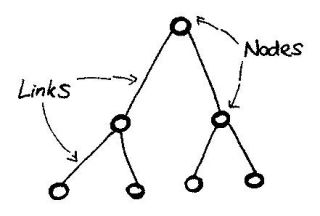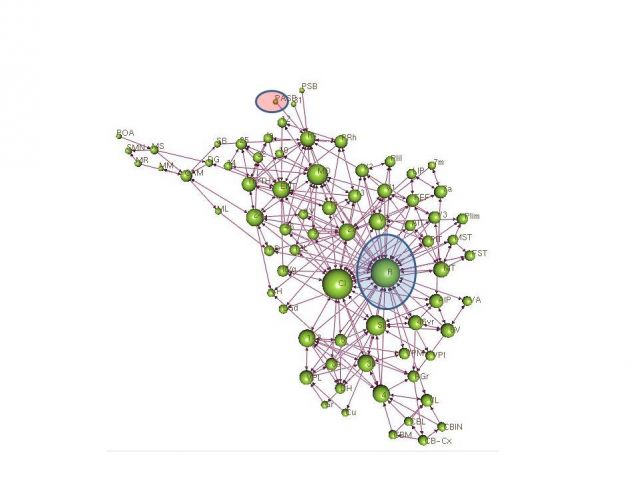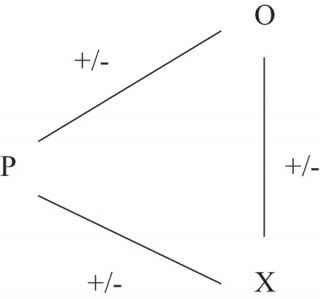Flow
Mapping Your Position in Cultural Space
A framework for mapping cultural space.
Posted August 28, 2015
This blog invites readers to adopt a bird’s eye view on human social behavior by conceptualizing people as “nodes” in social space. This diagram is a representation of interacting nodes.
If we think about each node as a person, what would the lines mean? They would represent lines of influence and information flow. What about the space in general in which these nodes, connected by influence and information, exist? What is the best way to conceptualize this space? According to the unified approach, human verbal interaction gave rise to a novel dimension of complexity, labeled Culture. Culture is given with a capital “C” to differentiate it from “culture” in animals, which refers to group traditions and transmission of learning and communication. Other animals, like chimps and dolphins, have culture in that sense. However, capital “C” Culture refers to the systems of justification that emerge via human verbal communication. That is, the nature of human verbal communication was such that it ultimately functioned to legitimize action. An insight here is that it means that the verbal, self-conscious portion of your mind (the portion most commonly associated with the conscious “I” who "chooses" what to do and say) works as a system of justification that engages in reasoning to give reasons for which actions or ways of being or claims are most legitimate.
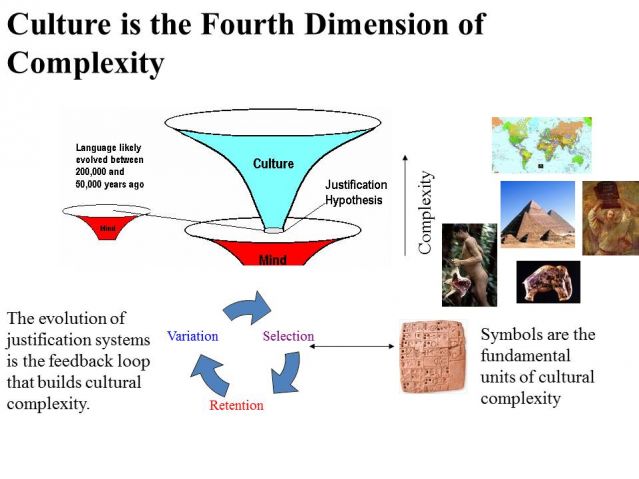
So now think about your “self-conscious being” as a point in justification space. When we do that we can then think about the geometry of human social relations as being represented by the lines and location of other nodes. This gives us an opportunity to think schematically about interconnectedness and social influence. That is, as anyone who craves fame and celebrity status will tell you, some people have power and influence and some do not! We can see this represented in this next diagram (which is actually a nodal schematic of brain activity), where we can represent how people occupy very different places in society.
For example, we could represent President Obama via the blue circle and this would represent how he occupies one of the most the central nodes in the US, and maybe the in the world. In contrast, some of the folks I saw in the suicide attempter study (as described here) would be would be represented by the red circle. These individuals have almost no interconnection or influence (and, not surprisingly, were largely miserable).
There are a couple more layers needed to fully grasp what I mean by position in social space. One element that I hope is fairly straight forward, at least conceptually, is that not all connections and relations between nodes (i.e., people) are positive and enhancing. Influence/information can be either designed to support an individual or group and justify their influence or can be intended to diminish their legitimacy or power. It is worth noting here that the dynamics of positive or negative attitudes in group relations is one of the older areas of inquiry in social psychology. Fritz Heider began to explore this concept in his balance theory, and here is one of his basic diagrams.
P, O, and X can each be considered a person and the lines are their connection. We can include positive and negative valence signs attached to each of the lines. These lines would represent whether the flow was influence/ information was designed to enhance or diminish the influence of the node.
Thus, if we returned to a representation regarding President Obama, we might include positive and negative lines of information/influence.
The final layer I would like to add here is the dimensional analysis offered framed by the Tree of Knowledge System. Here we need to consider the context in which Culture or (“justification systems space”) exists. The ToK System depicts nature as a nested hierarchy. That means that there are emergent dimensions of complexity that are “nested” within other dimensions. The dimension of justification is nested within the mental dimension. The mental dimension includes cognition, experiential consciousness and animal action. The mental dimension is nested within the biological dimension and, finally, the biological dimension is nested within the physical/material dimension.
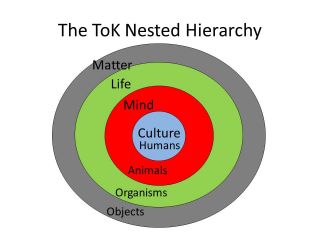
Why is this important? Because someone might point out, legitimately, that not all influence/information exchange between humans is mediated via verbal justifications. For example, if an American sniper takes out an enemy combatant, surely the bullet diminishes the influence of the other, but it is not well-characterized as a “justification”. Shooting someone, punching someone, making love to someone, and on and on are mental behaviors, not justifications. Now, justifications emerge out of and feedback on mental behaviors. Thus, we can presume that the American sniper had “justifications” that organized and guided his mental behaviors, as do brawlers and sexual partners.
In short to make sure we have a full conceptual understanding of this picture according to the unified approach, we need to see Culture (i.e., human justification space) as an emergent dimension, nested within a broader dimension of Mind, which in turn is nested within Life which is nested within Matter.
But we are not quite done with our nested analyses because, according to the unified approach, evolution is not “finished” at the level of Culture. The unified system very clearly argues that what gives rise to a new dimension of complexity is the emergence of a new system of information processing. Thus, genetic information processing creates the dimension of Life, neuronal information processing the dimension of Mind and human language (open symbolic syntactical processing) the dimension of Culture. We can ask, then, hasrecently there been the emergence of novel information processing? Electronic information processing in the form of computers and the internet and now social media have emerged in the last fifty or so years. Although these systems emerged out of human justification systems, they now are beginning to take on a life of their own. This is why our age is both so exhilarating and terrifying. No one knows what this dimension of complexity, which I have tentatively labeled “MetaCulture”, will bring.
According to the unified theory, every person occupies a node in Cultural space. The goal here has been to provide you with some tools to think about your existence in that space. These tools, by design, have been framed in a very analytical way at this point. That is, by framing social processes and exchanges in terms of geometry in human social space, we can provide a pretty objective description of human behavior at this level. As a clinical psychologist, I also want to make sure I incorporate the phenomenological dimension of existence. But for now an "objective map" of social space can be a useful thing to use to get perspective on where we might fit into the larger universe.

